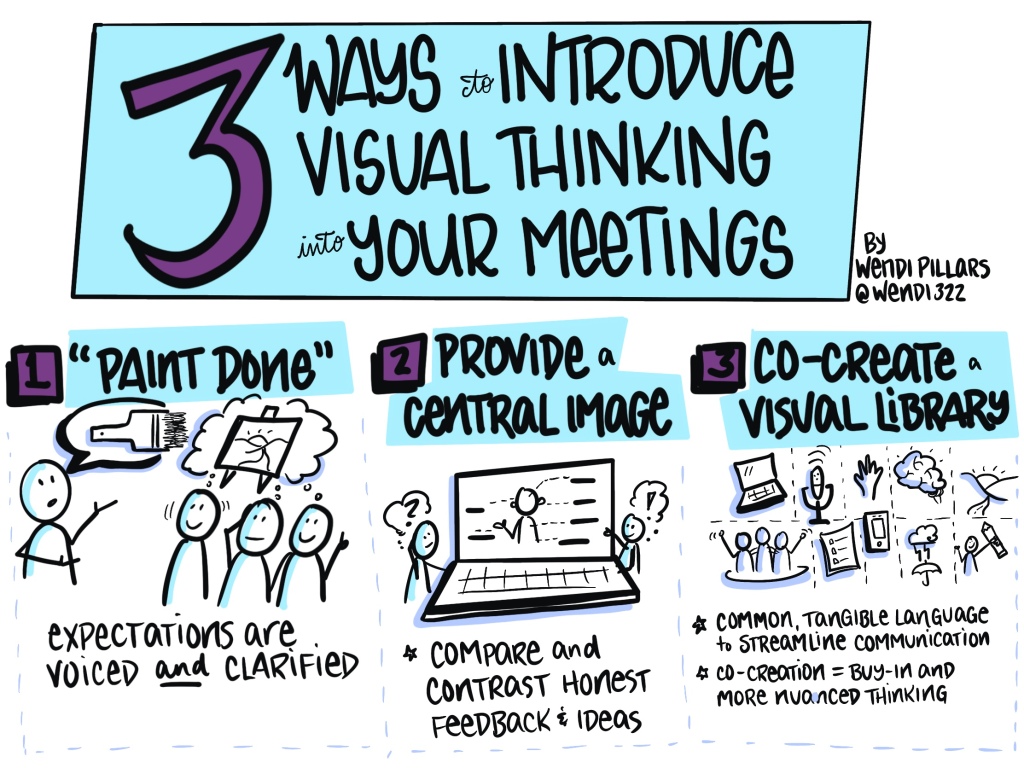
Psst…hey. Leading a meeting anytime soon? Here are 3 ways to introduce visuals into your meetings.
Paint done. Be crystal clear about what “done” looks like. This phrase and concept come from Brene Brown’s Dare to Lead and is an antidote to clarifying expectations. We’ve all been there, where we have expectations that are crystal clear in our own mind, yet we’ve never voiced them to others. Maybe it was a personal situation, maybe professional. Inevitably, frustration ensued and most likely the required expectation(s) were never achieved.
When you ask someone to Paint Done, however, you are asking to see a picture of what success looks like in a holistic view. It invites thinking from others who will be involved in the work, giving them the opportunity to make sure they have what they need to do what is being asked of them.
Reality check, space to tackle tough conversations, and authentic collaboration? Check.
Provide a central image, whether it is of your customer, ideal client, employee, or even the competition. It does not have to be fancy and in fact, you might be amazed at the power of your stick figures to finesse conversations. Using an image recalibrates your thinking by tapping into the visual brain. The central figure serves as a neutral anchor for everyone’s focus, and your group can use it in multiple ways, even virtually.
In practice, you can use breakout rooms for groups to respond to your prompt. Let’s say you’re reconfiguring your ideal customer during times of COVID19. Rather than elicit ideas from a huge group, smaller groups can converse then you can see where the overlapping ideas among teams exist and where disparities reside. Enter greater thought diversity.
Alternatively, a second idea is to ask teams to annotate directly onto the screen using the text feature, typing out descriptive phrases. The anonymity of this feature may be a comfortable boost to those who want to speak against the tide, allowing you to gain real feedback you wouldn’t otherwise glean from a larger, inhibited “public” group.
Co-create a visual library. Choose 10 icons or simple sketches to represent concepts you are continually discussing, challenges you are facing, aspects you are celebrating, and more. The co-creation piece can be done within set organizational teams, OR among different teams that don’t typically work together for cross-pollination of ideas.
Once you have those common shared images, they can be used as shortcuts in meetings, on organizational material (newsletters, memos, PR materials, etc.), during mentor/ mentee meetings, as building blocks to spur greater creativity or to enhance communication among different departments. The resultant shared understanding enlivens conversations, clarifies information, specifies requests for action, and illuminates processes, all because the focus is more tangible when seeing our words on paper or screen.
In other words, use simple visuals to help you drill down to the essence of your meeting by helping you clarify what you want to say, connect the dots, prioritize topics and ideas, and specify next steps.
Warning: once you use visuals to get clear, focused and action-imminent, you’ll never go back. Prepare thyself.
